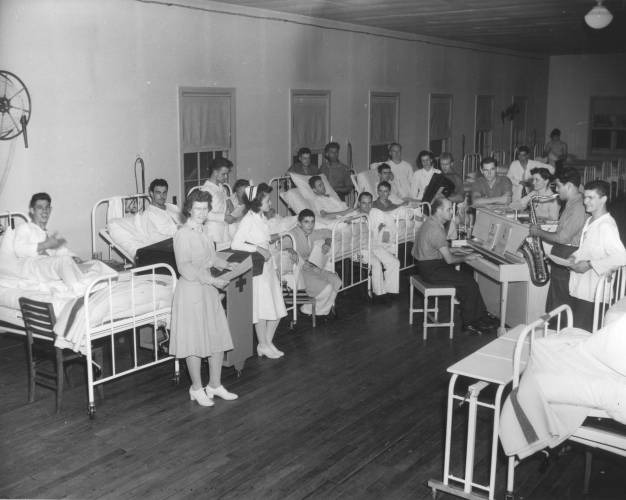
Notes from Sick Bay
Q 2 2009
A year ago, I wrote about a Naval Hospital based at the inland Naval Training Center in Farragut, Idaho. The Navy set up a similar establishment in the east, in rural New York State. Named after a hero of the Battle of Santiago in the Spanish-American War, U. S. Naval Hospital, Sampson, New York had a short but honorable existence during World War II.
The flu bug has been in the news quite a bit lately. Here's your influenza virus primer.
Respectfully submitted,
Tom Snyder, MD
Captain, Medical Corps
U S Navy, Retired
Surgeon General
Naval Order of the United States
In the photo: Hospital entertainment in days before Television
Historical Half Minute-U. S. Naval Hospital, Sampson, NY
Notes from Sick Bay
In May 1942, President Roosevelt approved selection of the site for a Naval Training Center on farm and vineyard land at the southern end of Seneca Lake, the largest of New York State's Finger Lakes. The Naval Hospital was placed on 455 acres adjacent to the Training Center. Site clearing commenced immediately, and in October 1942, Captain Claude V Carr, MC, USN, reported for duty in connection with establishment of the hospital. The hospital's first ward opened in January, and the hospital commissioned on 27 February 1943. Originally, it consisted of nine permanent buildings constructed of stone and at least 25 "temporary" structures which actually constituted the wards, surgical buildings, labs, x-ray spaces and residences for hospital staff. At its peak, the hospital had 141 buildings containing and supporting 1000 beds. Medical and support staff grew to include 32 medical officers, 214 nurses, and 640 enlisted personnel including 104 Hospital Corps WAVES.
Rehabilitation of injured and wounded personnel became a major emphasis at the hospital with the establishment of the Rehabilitation Service in September 1944. In the first 8 month of 1945, nearly 32,000 treatments were given to more than 840 patients.
In the photo: Hospital entertainment in days before Television
A small crew's library was established soon after the hospital opened in 1943. By January 1944, the library was actually broadcasting a weekly program of reading to all parts of the hospital, and later instituted a broadcast utilizing music from the library's record collection.
The hospital medical service cared for large numbers of infectious diseases among trainees, the new antibiotic penicillin being used to cure several hundred cases of pneumonia. The surgical service was a busy one: more than 1800 operations were performed in 1943, and as many were done in the first 8 months of 1945. Hernia repair was the most common surgical procedure performed, with appendicitis being the most common acute surgical condition.
As the war wound down, Training Center activity decreased, and the hospital became a center for the care of tuberculosis patients. When the TB patients were transferred to VA hospitals around the country, NH Sampson closed 1 July 1946; it experienced a brief renaissance during the Korean Conflict, but thereafter fell into disuse and neglect. Today, the only building that remains in the old hospital site is the brig, now Sampson World War II Navy Veterans Memorial Museum.
Respectfully submitted,
Tom Snyder, MD
Captain, Medical Corps
U S Navy, Retired
Surgeon General
Naval Order of the United States
=====================
Please send me with your article ideas, requests or constructive criticism. Contact me at tlsnyder@history-havy-med.org; 131 el Camino Real, Vallejo CA 94590-3464; 707.643.8937; if you want information about The Society for the History of Navy Medicine, check out our website at
www.history-navy-med.org,